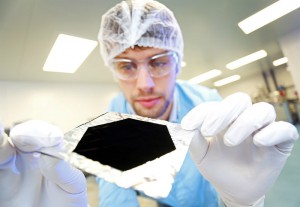
Back in 2014, Surrey NanoSystems introduced a material called Vantablack, that until now was the the darkest, most blackest material ever invented. The company claimed the material was capable of absorbing 99.96 percent of light, but apparently this was not dark enough. This week Surrey NanoSystems announced that they’ve made Vantablack even darker, so dark in fact that spectrometers can’t even measure it.
Vantablack is composed of a forest of vertical carbon nanotubes that absorbs radiation in the visible spectrum. When light strikes the material, instead of bouncing off, it becomes trapped and is continually deflected between the tubes before eventually becoming heat. The heat, that is largely undetectable in most applications, is conducted to the substrate and dissipated
Carbon nanotubes are hollow structures with one or more walls formed from atom-thick sheets of carbon. Each tube is around one fiftieth of one millionth of a meter in diameter, making it an ideal and appropriately sized building block for engineering structures that exhibit low-reflectivity and high-emissivity across a wide-range of frequencies.
Unfortunately the fine nanometre-sized optical cavities, that make Vantablack so dark, also means it cannot be used in environments open to direct contact and mechanical abrasion. It needs to be protected from accidental touching, for example behind or inside a component, or situated where contact is avoided. There are however still many possible applications for Vantablack as the material has several attractive properties beyond it’s incredible ability to absorb light
Some of these properties are:
- The height of a Vantablack coating is typically around 20 to 30 microns and the high proportion of free-space within Vantablack (>99%) makes it extremely light. One square meter of coating weighs only around 2.5g.
- The carbon nanotubes have an exceptionally high modulus of elasticity and will therefore flex and bend, making them very robust in environments subject to extreme shock and vibration.
- The strength of the nanotubes bond to the substrate is high, making it difficult to remove the material through thermal cycling, shock or vibration. It is however sensitive to mechanical abrasion.
- The structures are incredibly tolerant to thermal cycling as a result of the intrinsic properties of the carbon nanotube building blocks, and their ability to adhere to a substrate.
The characteristics of Vantablack are of course highly desirable in space applications, where components are subjected to extremes of thermal-cycling, mechanical shock, vibration and exposure to high-vacuum. There are however additional possible application the material can be used for as: solar energy, spectroscopy, cinematography (projectors, visual FX), architecture and more.
The name Vantablack® stands for Vertically Aligned Nanotube Array black.
Video below demonstrates how effective Vantablack is at absorbing light:
